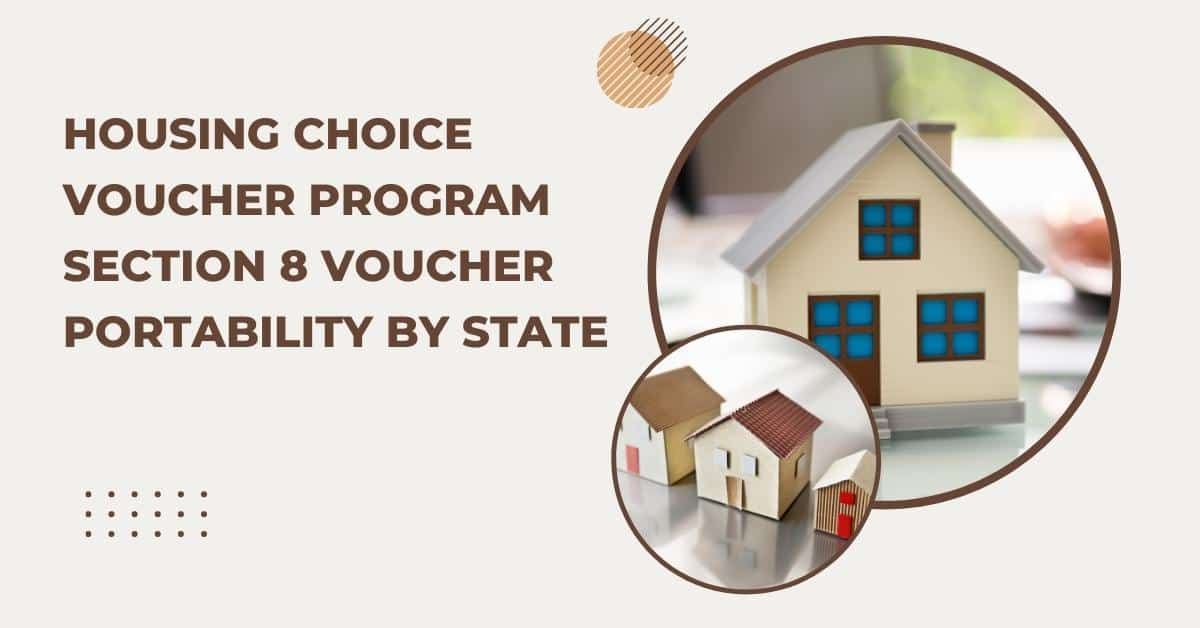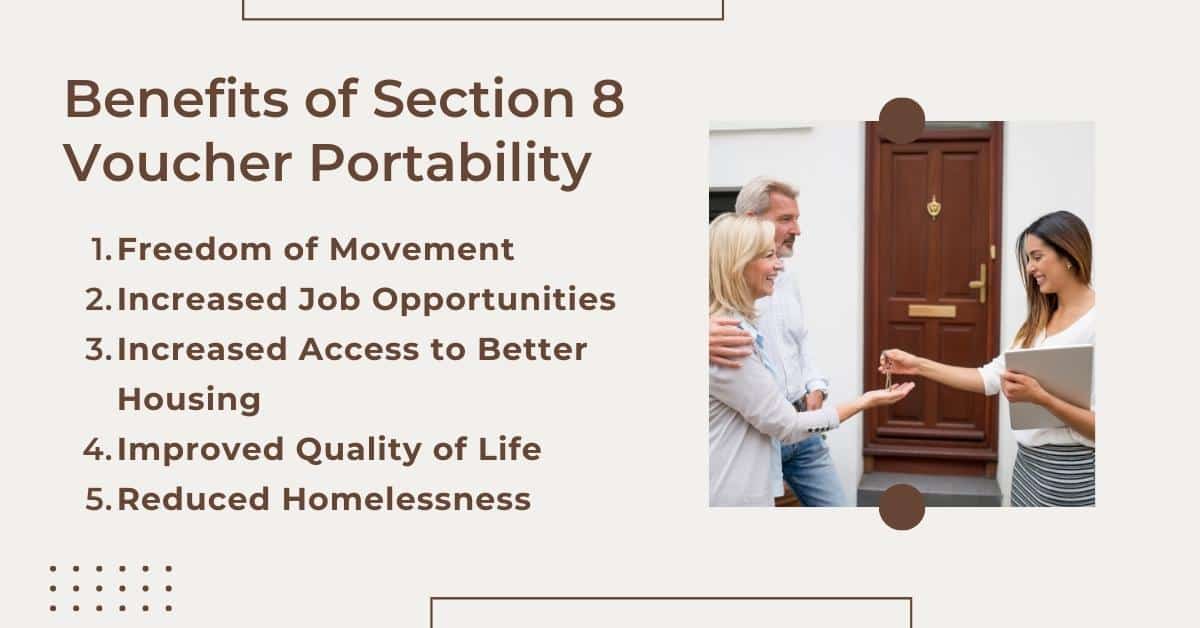Are you a low-income renter with a Section 8 Voucher? Do you want to move to another state but don’t know if your voucher will work in that location? The Housing Choice Voucher Program (Section 8) allows voucher holders to move between states, however, the rules and benefits of this “portability” vary from state to state.
In this blog, we will discuss the benefits of Section 8 voucher portability, list the states that allow it, and outline the advantages and challenges associated with it.

What is Section 8 Voucher Portability?
Section 8 Voucher Portability allows recipients of the Section 8 voucher program to move within or outside of their jurisdiction’s area without losing their voucher. These vouchers provide assistance to low-income families, the elderly, and disabled individuals by subsidizing rent payments for affordable housing units certified by local Public Housing Agencies.
By allowing portability for voucher holders, individuals are free to pursue more career opportunities in distant cities, attend school elsewhere, and take advantage of housing markets with lower costs of living.
The transferee Public Housing Agency is responsible for verifying the family’s continued eligibility requirements once they arrive at the new location prior to authorizing rental assistance. This helps support vulnerable populations as they seek out better housing options throughout the country.

Benefits of Section 8 Voucher Portability
Section 8 Voucher Portability provides a variety of long-term benefits for individuals, families, and households that are struggling in the current housing market. With Voucher Portability, households can choose to remain in their current location or select a new residential area where they may find greater access to resources.
Through this program, those who are eligible can take advantage of better housing options that may not have been otherwise available to them. Its value lies in its ability to provide long-term stability and foster an improved quality of life for low-income renters.

- Freedom of Movement: Voucher holders are provided with the flexibility to find housing options that best fit their needs without losing their vouchers.
- Increased Job Opportunities: Portability allows people to move to areas with better job opportunities, helping them achieve economic stability and break out of poverty.
- Increased Access to Better Housing: Portability provides people with access to better housing opportunities, allowing them to live in more desirable neighborhoods that have lower crime rates and better schools.
- Improved Quality of Life: People who benefit from portability are provided with the chance to improve their quality of life by having access to higher-paying jobs, better housing, and more educational opportunities.
- Reduced Homelessness: By allowing voucher holders to move to areas with lower rent costs, portability helps reduce the risk of homelessness for low-income families.
List of States That Allow Voucher Portability
As parents navigate the complexities of the modern education system, one decision they face is determining which schools to send their children to. Voucher portability allows families to ensure their children receive access to the educational opportunities that best suit the needs and wants of a family.
Here we provide a list of states that allow voucher portability so families can research their options and make well-informed decisions when it comes to choosing their child’s academic home.
- Alabama
- Alaska
- Arizona
- Arkansas
- California
- Colorado
- Connecticut
- Delaware
- District of Columbia
- Florida
- Georgia
- Hawaii
- Idaho
- Illinois
- Indiana
- Iowa
- Kansas
- Kentucky
- Louisiana
- Maine
- Maryland
- Massachusetts
- Michigan
- Minnesota
- Mississippi
- Missouri
- Montana
- Nebraska
- Nevada
- New Hampshire
- New Jersey
- New Mexico
- New York
- North Carolina
- North Dakota
- Ohio
- Oklahoma
- Oregon
- Pennsylvania
- Rhode Island
- South Carolina
- South Dakota
- Tennessee
- Texas
- Utah
- Vermont
- Virginia
- Washington
- West Virginia
- Wisconsin
- Wyoming
While the rules and regulations regarding voucher portability may vary slightly from state to state, they are generally established by the federal government and must be followed by all participating states.
Some of the key rules and regulations regarding portability include:
One-year residency requirement: Families must live in a unit for at least one year before being eligible to move with their voucher.
Quality standards: The new unit must meet certain quality standards, which are established by the local Public Housing Authority (PHA).
Approval from both PHAs: The family must receive approval from both their current PHA and the PHA in the area they plan to move to.
Availability of funding: The family must also ensure that there is available funding in the area they plan to move to.
Timely notification: The family must give timely notification to their current PHA before moving.

Advantages of Voucher Portability
One of the major advantages associated with voucher portability is that it allows tenants to transfer their current Section 8 voucher to a different jurisdiction. This helps low-income households transition into more desirable neighborhoods by allowing them to access housing assistance even after relocating to another city or state.
Furthermore, voucher portability reduces the administrative burden on agencies and program providers, as it cuts down on paperwork and streamlines the process for participating households. Additionally, research indicates that voucher portability can result in significant cost savings for both tenants and the government compared to traditional public housing.
All of these factors combine to make voucher portability a valuable asset that can help thousands of individuals take advantage of housing assistance opportunities from one location to another.

Challenges of Voucher Portability
Mobilizing education resources equitably across states and districts has many challenges, particularly when it comes to voucher portability. Voucher portability requires states, districts, and other participating parties to ensure equitable access and availability of resources for all students.
Unfortunately, due to injustices in our education system, some areas just have inadequate resources or restrictions on the types of aid that can be offered. This prevents some students from having access to crucial educational opportunities and experiences.
To combat this problem, districts must remain alert and proactive in working together to find creative solutions to ensure fairness and equal opportunity.

Conclusion
Voucher portability is a valuable tool for low-income households to access housing assistance regardless of where they live. It helps tenants transition into more desirable neighborhoods and offers cost savings to both the tenant and the government.
However, there are still challenges that must be overcome in order for all students to have equitable access to educational resources across states and districts. With the right strategies and initiatives in place, voucher portability can be a powerful tool that helps people at all income levels access affordable housing.












